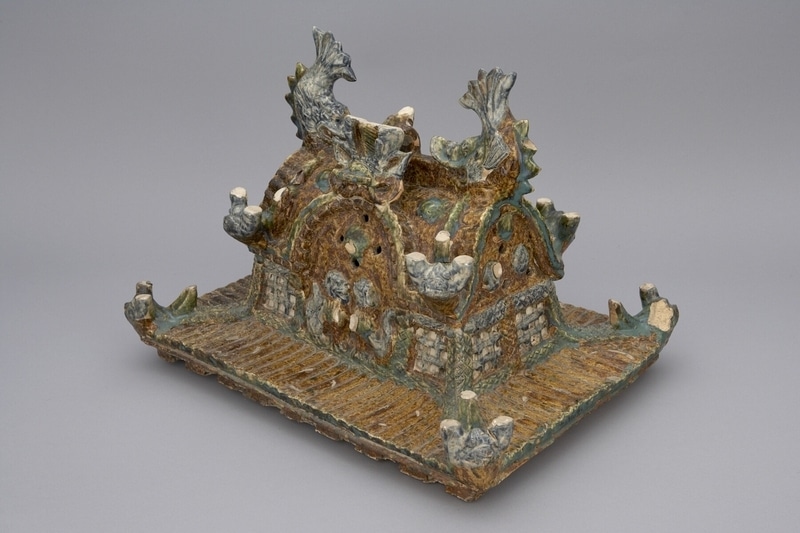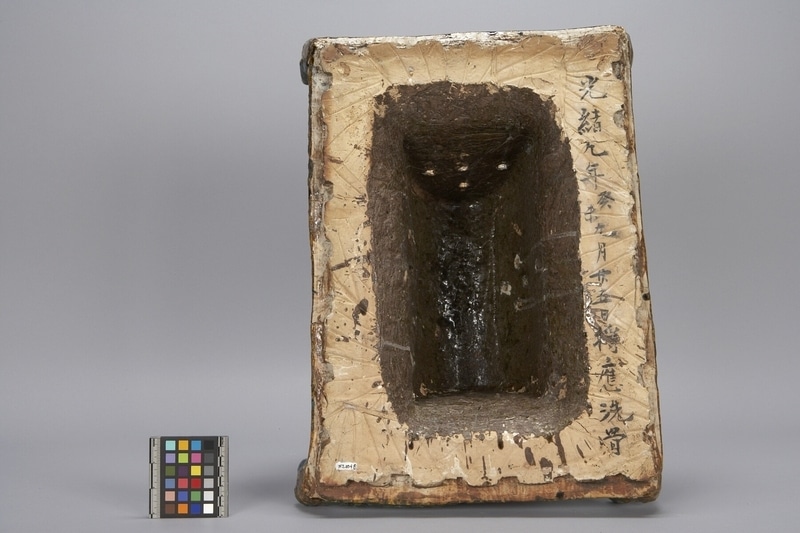Urn Lid Item Number: N2.1048 from the MOA: University of British Columbia



Description
Large ceramic lid from a funerary urn. The recangular lid is in the shape of a palace roof. At the end of the ridge of the roof are three-dimensional shachihoko (鯱鉾/鯱), a mythical sea creature with the head of a tiger or dragon and the body of a fish, projecting upward. On both sides are the heads of shishi (獅子), a mythical guardian lion, protruding outward. Glaze colours are predominantly turquoise and brown. The epitaph called migachi or miigachi (ミガチ/ミーガチ/銘書) in Okinawan is on the bottom of the urn lid.
History Of Use
The urn (body with lid) is known as a jiishigaami or jīshigāmi (ジーシガーミ)in Okinawan, and zushigame (厨子甕) in Japanese. Okinawans used to practice shinkuchi/senkotsu (シンクチ/洗骨/ bone-washing) as a form of reburial, and the washed bones were placed in such urns. Historically, the deceased were either left in the open air or placed in a large family tomb during the first period of internment, and after several years, the family would gather and clean the bones before placing them in the jiishigaami. Okinawa (沖縄) was ruled by the Ryūkyū ōkoku (琉球王国/ Ryūkyū kingdom) from 1429 until Japan annexed the island in 1879. Trade with Japan, China, Korea, and Southeast Asia influenced social practices in Okinawa, but distinct cultures in the archipelago remain vibrant.
Cultural Context
funerary urn
Narrative
The epitaph, on the bottom of the lid, is called migachi or miigachi (ミガチ/ミーガチ/銘書) in Okinawan, and reads: "the bones were washed on September 15 in 1883 as indicated by the Chinese year of the 9th reign year of Guangxu Emperor (光緒九年) during the Qing dynasty. It was likely for a person named 将應."
Item History
- Made in Okinawa, Japan during 1883
- Collected by Wayne Suttles during 1954
- Owned by Wayne Suttles before 1954
- Received from Wayne Suttles (Seller) and University Purchase (Funding source) during 1954
What
Who
- Culture
- Okinawan
- Field Collector
- Wayne Suttles
- Previous Owner
- Wayne Suttles
- Received from
- Wayne Suttles (Seller) and University Purchase (Funding source)
Where
- Holding Institution
- MOA: University of British Columbia
- Made in
- Okinawa, Japan
When
- Creation Date
- during 1883
- Collection Date
- during 1954
- Ownership Date
- before 1954
- Acquisition Date
- during 1954
Other
- Item Classes
- ceramics
- Condition
- fair
- Current Location
- Case 82
- Accession Number
- 2171/0128